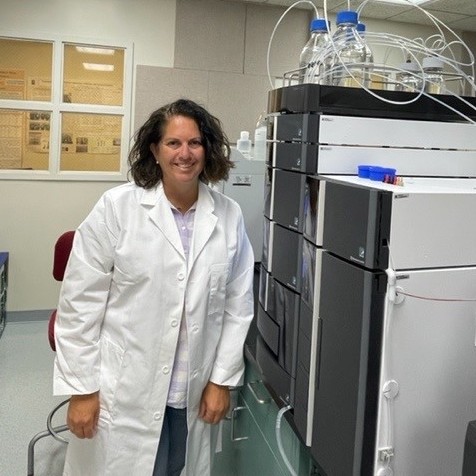
Lee Green is a chemist in the Illinois Sustainable Technology Center’s Applied Research on Industrial and Environmental Systems (ARIES) group. She studies persistent contaminants, specializing in microplastics and PFAS. Scientists are just beginning to discover the impacts that these contaminants have on the human body and the environment.
Lee recently answered some questions about her work.
In one sentence what do you do?
I research persistent contaminants in the environment, specifically microplastics and PFAS.
What is your educational background/areas of expertise?
I have a degree in biology, worked for Abbott labs for five years, then moved, and have been doing different analytical jobs since moving here to Champaign. It’s kind of funny how it worked out because I always thought I’d be doing medical or cancer research, but life takes you in a different direction sometimes, especially if you’re open-minded.
How does your work at ISTC impact Illinois and the world?
The microplastics research is eye-opening for people in general as far as how widespread they are. They’re in our foods and water and our waterways, and people don’t realize how prevalent they are. I hope somewhere down the road we can figure out how to start cleaning up the microplastics or taking control of the issue and bringing light to recycling. There’s still so much research that needs to be done. It’s literally everywhere in things that we use on a daily basis. There’s still not a lot of data out there on the potential health risks as well.
What is the best part of your job at the ISTC?
I love the fact that we’re constantly looking at new projects. Right now we’re looking at microplastics and next, depending on who we collaborate with, we might be working on PFAS. I’m working on a project funded by ISTC’s Hazardous Waste Research Fund (HWRF) that looks at wastewater and how microplastics are transported through the system. I like how you get a different flair of research projects, so it’s never the same thing over and over again. I like the diversity. And the people, I like the people I work with, they make it fun. There’s a lot of great ideas floating around. Not just the projects I work on, but the other projects and seeing how they all collaborate and come together.
What work/project/outcome are you most proud of?
Probably the microplastics projects we’re working on now, even though we’re in the middle of some of these projects. It’s such a hot topic and I think the more work we do the more we see how broad of a problem it is and how it affects people on so many levels. We haven’t published any major papers yet, but I can see that coming in the future. We know a lot about PFAS, how they act, and where they’re found, but microplastics is a whole new world of where to go next. They’re even starting to look at human effects like in the lungs and the tissue and how it is transported in the body. Does our body get rid of that or does it bioaccumulate over time? No one really knows.
What are common misconceptions about your field?
People are always like “Wow you must be really smart then, right?” It’s fun, I really enjoy running the instruments and finding something that you didn’t know was going to be there so it’s funny because people’s reactions are always different.
How old were you when you first became interested in science and what sparked your interest?
It was definitely my junior year in high school. I think I was in anatomy and physiology or biology and I think it was my biology teacher back then, Mr. Kurt Kreiter, who made it so fun. That was a huge spark for me. He made science really interesting and ever since then I’ve been interested in biology and the human body.
When you aren’t doing science what else do you like to do?
I love to golf. I like to bike and cook, go for walks, cruise around in my convertible, and do fun things in nature. Yardwork, taking care of the garden, we just put up a birdfeeder, so nature in general.
What is your favorite tool to use in your everyday work?
Sample prep and analytical analysis. I like to work with my hands and figure out how to process the samples and then run them on the instruments and figure out all the concentrations. I really like the hands-on and analytical aspects of my job.
Is there a particular analytical tool that you like to use?
I’m just learning how to run our new LC-MS (Liquid Chromatography Mass Spectrometer), so that’s exciting, but I’ve always been a fan of the ICP-MS (Inductively Coupled Plasma Mass Spectrometer). There’s just something about seeing the concentrations and figuring out if it’s a good or bad number or “well we really shouldn’t be seeing that in this piece of plastic”. It’s interesting to digest the plastic and see some of the chemicals that used to be used in plastics.
What is your work uniform?
I typically wear jeans, tennis shoes and a t-shirt. But obviously, in the lab we wear lab coats and glasses depending on the chemicals we’re using but we’re pretty casual, which is awesome.
This story originally appeared on the People of PRI blog. Read the original story.

